Not all animals can be tigers or dolphins! For every “supermodel” animal there are hundreds of ugly animals that play just as an important part in their respective ecosystems. On this page is a list of the world’s ugliest animals, with pictures and interesting facts on each species.
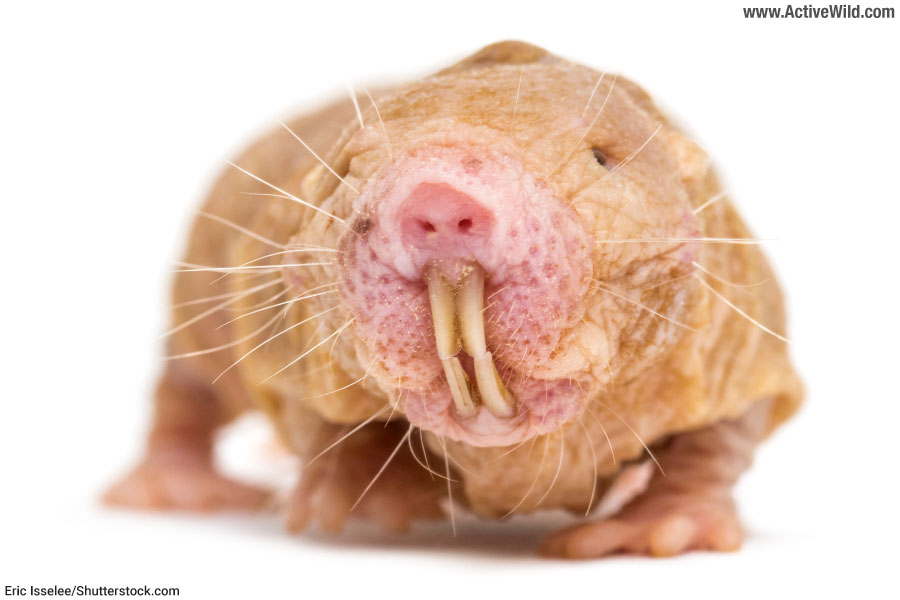
Ugly Animals Examples
Examples of ugly animals include mammals such as the proboscis monkey, aye-aye, naked mole rat and elephant seals; reptiles such as Jackson’s chameleon and the thorny devil; fish such as the blobfish, goblin shark and the anglerfishes; birds such as vultures, the shoebill and the kakapo; and amphibians such as giant salamanders.
Endangered Ugly Animals
Sadly, many of the animals on this page are currently endangered. We’ve included the IUCN conservation status (source) of each species as a reminder that it’s not just photogenic animals such as tigers and red pandas that are under threat!
What’s your favorite ugly animal? Are there any species we’ve missed out? Let us know in the comments section!
Ugly Animals List
You can see more weird species on the following pages:
Weird Animals Pictures & Facts
Weird Plants Pictures & Facts
Discover More About Animals
Ugly Animals Pictures & Facts
Anglerfish
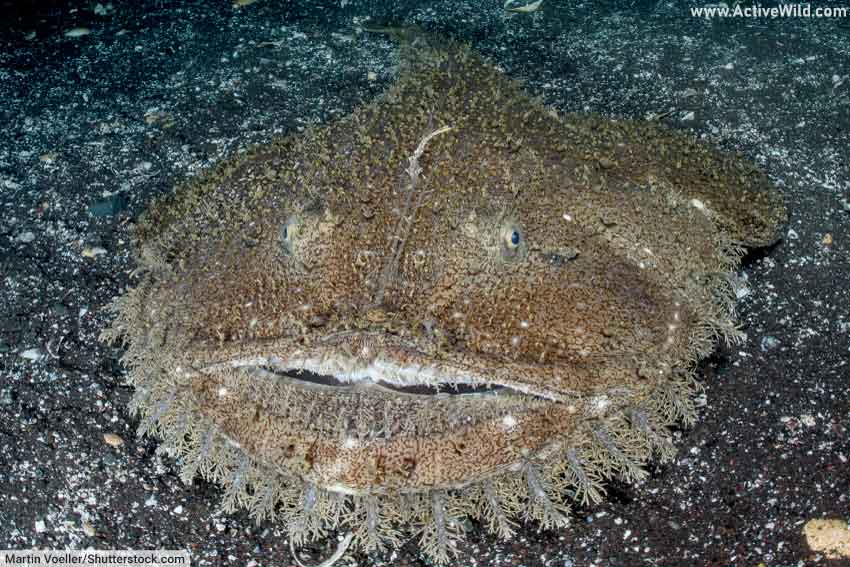
- Class: Ray-Finned Fish (Actinopterygii)
- Order Lophiiformes
- Conservation status: Various
Anglerfish are deep-sea fish known for their distinctive bioluminescent lure, which dangles in front of their mouths to attract prey in the pitch-black ocean depths.
These “ugly” fish are typically small, with some species exhibiting extreme sexual dimorphism, where the females are much larger than the males and often fuse the smaller males to their bodies for reproductive purposes.
Adapted to life in the abyssal zone, anglerfish possess a unique and fascinating biology that allows them to thrive in one of Earth’s most inhospitable environments.
Discover More
You can find out more about fish on this page: Fish – The Ultimate Guide
Discover different types of fish on this page: Types of Fish
Aye-Aye
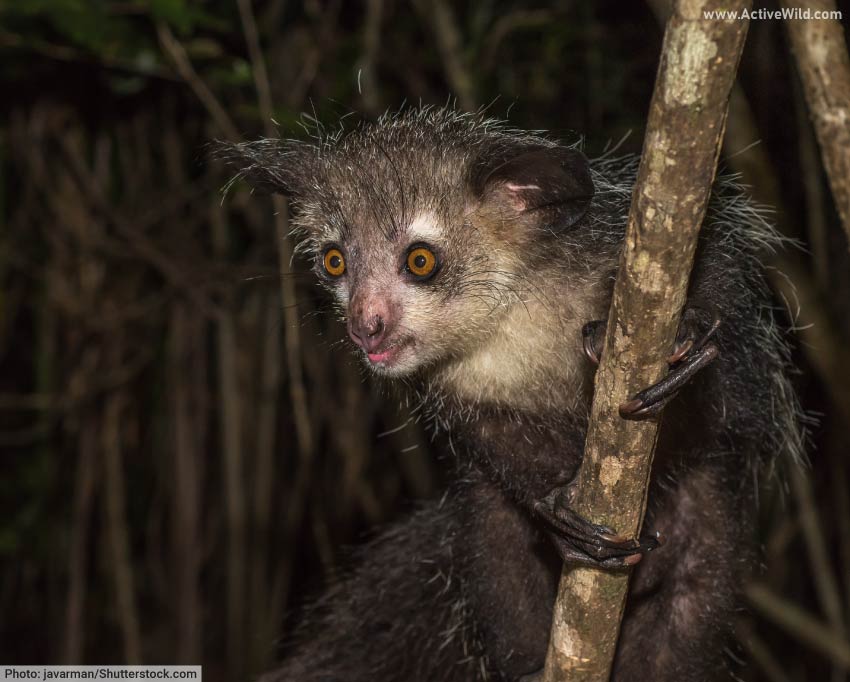
- Scientific name: Daubentonia madagascariensis
- Class of animal: Mammal
- Family: Strepsirrhini
- Conservation status: Endangered
Lemurs are a group of primates found only on the African island country, Madagascar. Of the hundred or so species of lemur, the aye-aye is without doubt the strangest.
This nocturnal primate prowls the forests of Madagascar under cover of darkness. As it moves through the trees, it taps on trunks and branches with its bone-like middle finger.
From the sound produced by its taps, the aye-aye can tell if there are any grubs (insect larvae) hiding under the bark. This form of echolocation is known as “percussive foraging”.
If it senses that food is present, the aye-aye makes a hole in the bark by gnawing into it with its sharp incisor teeth. It then probes inside the hole with its elongated fourth finger and pulls the grub out.
Unfortunately for the aye-aye, its odd appearance does not endear it to the island’s local people, who view the lemur as a bad luck omen.
Discover More
You can find out more about the aye-aye on this page: Aye-Aye Facts
You can find out more about primates on this page: Primate Facts
Bald Uakari
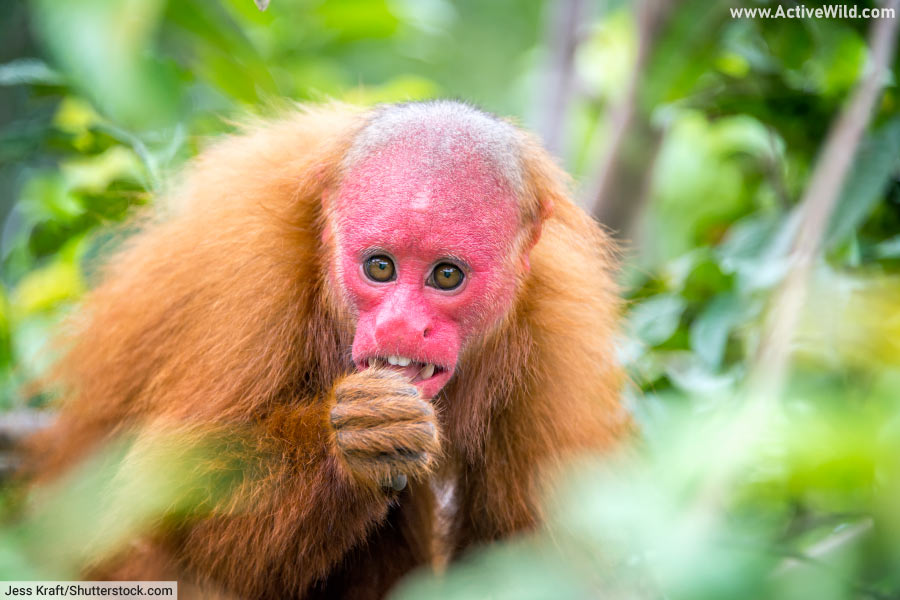
- Scientific name: Cacajao calvus
- Class of animal: Mammal
- Family: Pitheciidae
- Conservation status: Vulnerable
The bald uakari is easily identified by its bald head, red face and shaggy brown fur. The red color of its face is caused by blood vessels close to the monkey’s skin, which lacks pigment.
This distinctive primate is found in the Amazon Rainforest in Brazil and Peru. It inhabits várzea habitats – forests that are frequently flooded by whitewater rivers, and other swampy forest habitats.
The bald uakari is predominantly herbivorous, with seeds forming the majority of its diet. The species is one of four uakaris, which belong, along with the titis and saki monkeys, in the family Pitheciidae.
Discover More
You can discover more rainforest animals on this page: Rainforest Animals With Pictures & Facts
You can find out more about primates on this page: Primate Facts
Blobfish
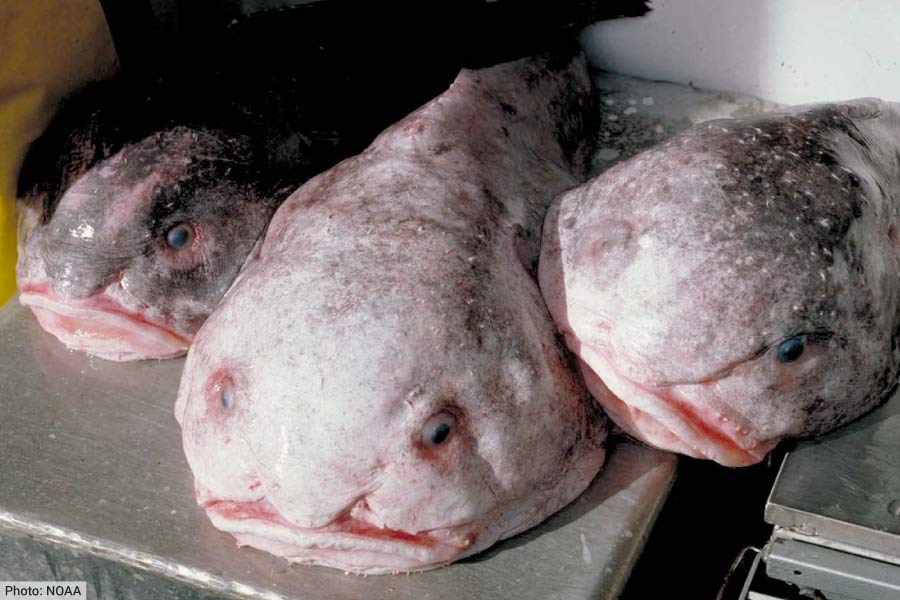
- Scientific name: Psychrolutes marcidus
- Class of animal: Ray-finned fish (Actinopterygii)
- Family: Psychrolutidae
- Geographic distribution: deep sea off the coasts of Australia, Tasmania and New Zealand
- Conservation status: Critically Endangered
Recognized by many as being the world’s ugliest animal, the blobfish, or blob fish, lives at depths of between 600-1200m, where the ambient pressure can be more than 100 times our atmospheric pressure!
What makes the blobfish seem ugly to our eyes are adaptations for living in such deep waters.
The body of the blobfish is a gelatinous mass, with a density lower than that of the water itself. This allows the blobfish to float above the sea floor without using energy to swim. The blobfish has minimal bone and muscle mass.
The species feeds primarily on floating debris and crustaceans.
In its natural habitat, the blobfish looks much more like a “normal” fish. However, when brought to the surface, the effects of decompression distort its features. The lack of strong bones and muscles to hold its structure, combined with the decompression symptoms such as skin expansion, turn its gelatinous tissue into a blob-like shape.
Discover More
You can see more amazing ocean animals on this page: Ocean Animals List with Pictures & Facts
Common Warthog
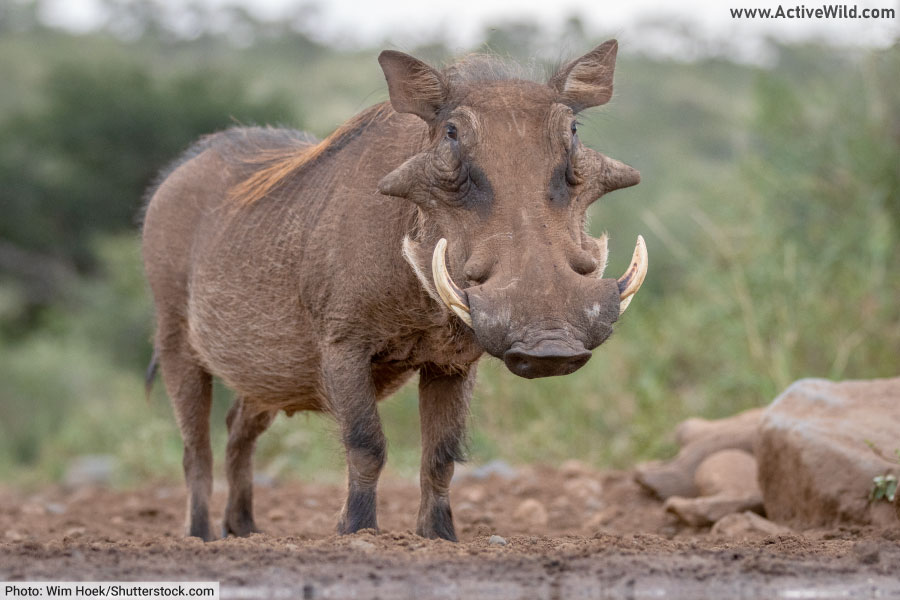
- Scientific name: Phacochoerus africanus
- Class of animal: Mammal
- Family: Suidae (the pig family)
- Conservation status: Least Concern
With its vicious-looking tusks, wide snout and massive head, the common warthog is not the most photogenic of African animals.
The species is one of two warthog species, the other being the desert warthog Phacochoerus aethiopicus, which is found in arid scrublands in Eastern Africa.
The common warthog, as its name suggests, is more widespread than its desert counterpart, being found across much of sub-Saharan Africa. Although it is not presently threatened, its population is decreasing.
Both warthogs are members of the pig family, Suidae.
Like other pigs, the common warthog is omnivorous. It grazes on grass and digs in the ground for roots and bulbs. It will also eat insects and carrion.
The warthog’s wide snout helps it to burrow and root around in the ground. Its four tusks are actually extra-long teeth that curve upwards, out of the mouth. They are used as weapons for fighting other warthogs and predators.
Discover More
You can find out more about the common warthog on this page: Common Warthog Facts
Condor (Andean & California)
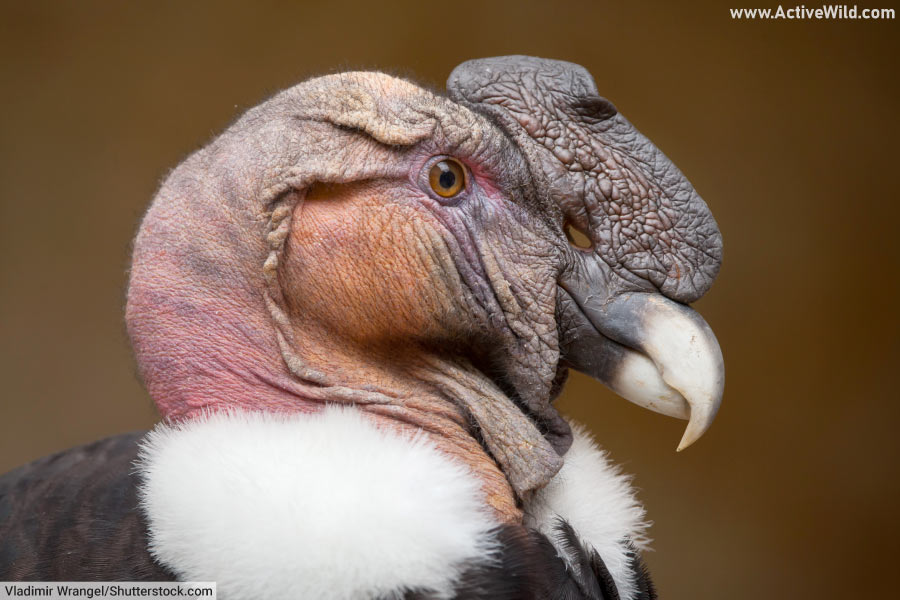
- Scientific names: (Andean condor): Vultur gryphus; (California condor): Gymnogyps californianus
- Class of animal: Bird (Aves)
- Family: Cathartidae (New World vultures)
- Geographic distribution: (Andean) Andean mountain range; (California) Southwestern USA and Baja California
- Conservation status: (Andean) Vulnerable; (California) Critically Endangered
There are two species of condor: the Andean condor and California condor. Both belong to the family Cathartidae – the New World vulture family.
Like other vultures, condors are large, broad winged birds. They may look graceful as they soar effortlessly through the sky, but seen close-up, neither of the two condor species could be described as attractive.
Condors have featherless faces with wrinkled skin and hooked bills. In addition, the male (which, unusually for birds of prey, is larger than the female), has a wattle (a flap of fleshy skin) hanging from its neck, and a fleshy growth known as a comb, or caruncle, on top of its head.
The Andean condor is around 100-130cm in length, weighs up to 15kg, and has a maximum wingspan of 3.3m. This huge bird is the world’s largest bird of prey.
Although the Californian condor is usually around 5cm longer than its close relative, it is slightly lighter and has a smaller wingspan.
Like all vultures, the condors are primarily scavengers.
Discover More
You can find out more about birds on this page: Birds: The Ultimate Guide
You can discover more amazing birds on this page: Amazing Birds List with Pictures & Facts
Dugong
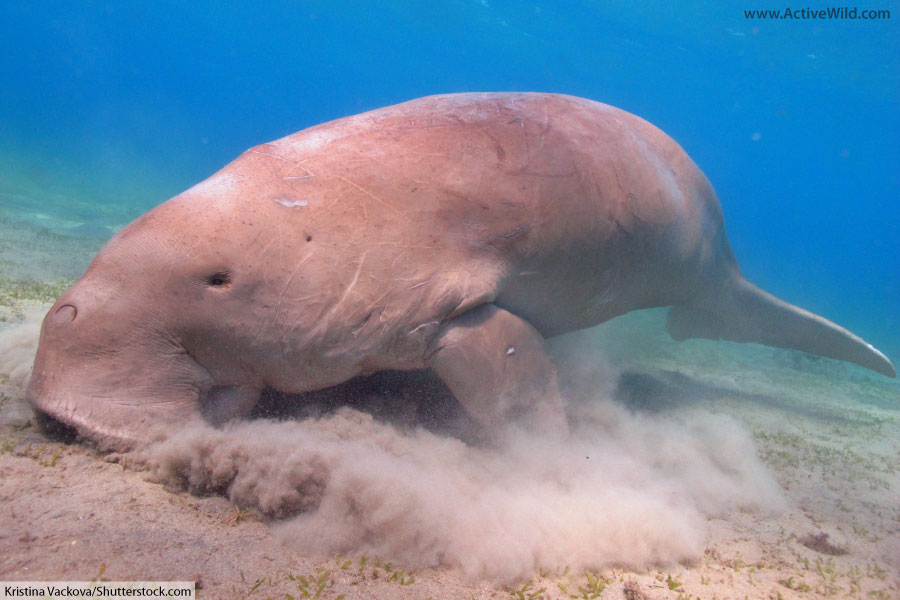
- Scientific name: Dugong dugon
- Class of animal: Mammal
- Family: Dugongidae
- Geographic distribution: warm coastal waters of the Indian & western Pacific Oceans, between ~26degrees to the north & south of the equator
- Conservation status: Vulnerable
The dugong is a large marine mammal found in the warm coastal waters, bays and lagoons of Africa, South Asia and Australia. The species is found on seagrass beds, and feeds on the grass-like marine flowering plants.
The dugong belongs to the same group of animals – the order Sirenia – as the manatees. Like the manatees, it is often referred to as a “sea cow”.
The dugong has a cylindrical body, and propels itself with flippers and a whale-like fluked tail. (The dugong’s fluked tail differentiates it from manatees, who have paddle-shaped tails.)
An adult dugong typically weighs between 200-400kg and is around 3m / 10 ft. in length, although some individuals can be significantly larger.
The dugong’s hairy, thick skin is naturally brownish-grey, but this color can vary depending on the algae that grows on it.
The dugong has a muscular, horseshoe-shaped, upper lip that is covered with sensitive bristles. This, together with the species’ acute hearing, helps make up for the small-eyed species’ limited vision.
The only external signs of a dugong’s ears are the small holes on the sides of the head behind the eyes.
When foraging, the dugong’s mouth forms a trunk-like shape. This gives the impression that the animal is “vacuuming” the sea floor.
Discover More
You can find out more about the dugong on this page: Dugong Facts
You can see more Australian animals on this page: Australian Animals List with Pictures & Facts
Giant Salamanders
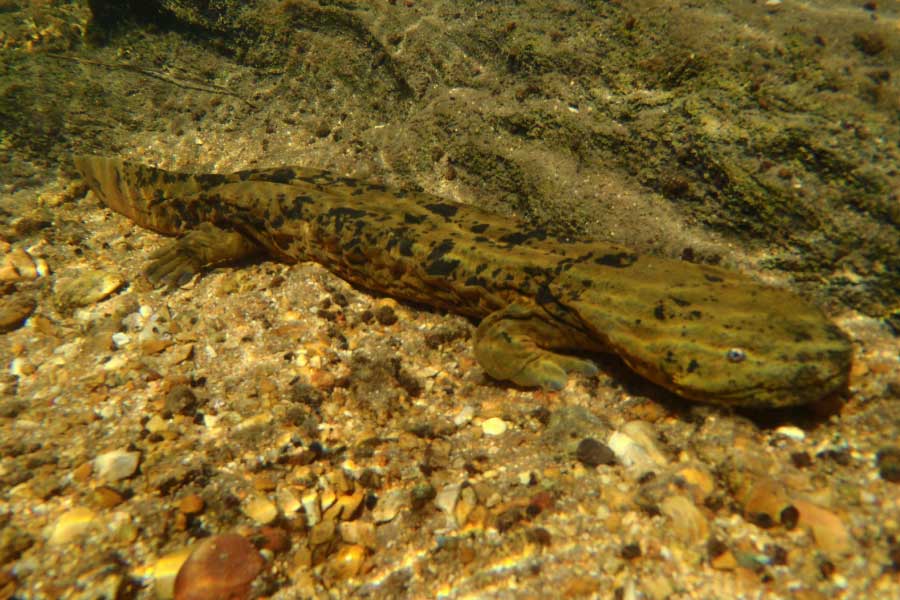
- Class of animal: Amphibian
- Family: Cryptobranchidae (aquatic salamanders)
- Geographic distribution: China, Japan, Eastern USA
Lurking under rocks in fast-flowing rivers and streams in both Asia and North America are a family of amphibians distinguished by their abnormally large size and by the frills of skin running along the sides of their bodies.
These overlarge amphibians are the giant salamanders of family, Cryptobranchidae. There are four (maybe five) species within this group: the Japanese, Chinese, and South China giant salamanders, and the hellbender, a species found in North America. (An additional species may also be present in China.)
The Chinese and South China giant salamanders, which grow up to 1.8m / 5.91 ft. in length, are not only the world’s largest salamanders, but also the largest living amphibians. Even the hellbender, the smallest of the group, reaches a length of up to 74 cm / 29 in.
Unlike many amphibians, which can live away from water after undergoing metamorphosis into their adult forms, the giant salamanders are fully aquatic, even after reaching adulthood.
The folds of skin that run along the sides of a giant salamander’s body are able to absorb oxygen. The folds increase the animal’s surface area, thereby increasing its oxygen-absorbing ability.
Although giant salamanders do have lungs and small nostrils, most of their oxygen is absorbed from the water.
Giant salamanders have poor eyesight, and hunt by smell and by sensing changes in the surrounding water pressure using nodes on their heads.
Discover More
You can find out more about the hellbender on this page: Hellbender Facts
Find out more about amphibians on this page: Amphibians: The Ultimate Guide
Goblin Shark
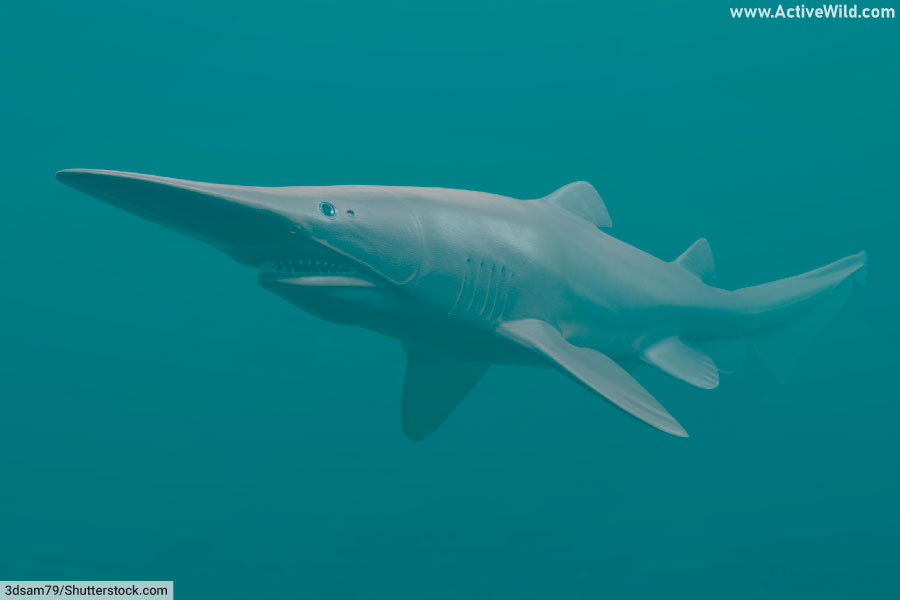
- Scientific name: Mitsukurina owstoni
- Class of animal: Cartilaginous fish (Chondrichthyes)
- Family: Mitsukurinidae
- Geographic distribution: global
- Conservation status: Least Concern
Sharks such as the great white shark and tiger shark may be fearsome animals, but they also possess a kind of deadly beauty.
The goblin shark, however, missed out on the good looks of its cousins. Instead, it looks like the stuff of a deep-sea diver’s worst nightmares, with its elongated nose, nail-like teeth, and alien-like jaws that can be extended – almost the length of its snout – to capture prey.
This rare, deep-sea shark is found in temperate and tropical waters all around the globe.
Very little is known about the species’ lifestyle and behavior. Most goblin sharks that have been found were between 3 and 4m in length, with one female reaching 6m.
Like all sharks, the goblin shark’s nose is equipped with organs known as ampullae of Lorenzini with which it is able to detect the electrical charges produced by the muscles of other ocean animals. This provides the shark with a “sixth sense” for hunting.
As if the goblin shark’s grotesque extending jaws weren’t enough, the species is also an unusual color. Its pinkish-grey shade is caused by blood vessels under the shark’s translucent skin.
Discover More
Find out more about sharks on this page: Shark Facts
Discover different types on shark on this page: Types Of Sharks
Hammer-Headed Bat
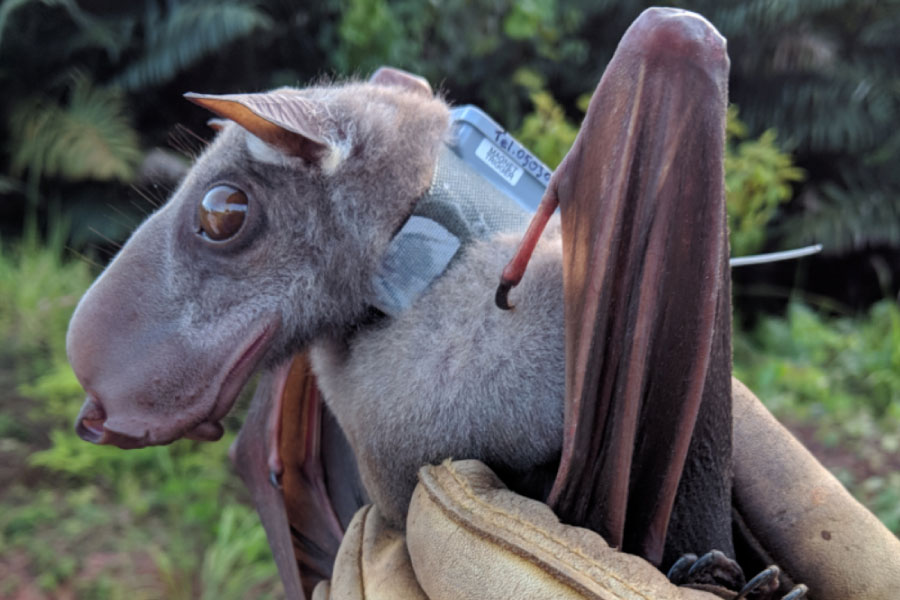
- Scientific name: Hypsignathus monstrosus
- Class of animal: Mammal
- Family: Pteropodidae (fruit bats)
- Geographic distribution: Western & Central Africa
- Conservation status: Least Concern
The hammer-headed bat, also known as the “hammer-headed fruit bat” and “big-lipped bat”, is the largest bat in continental Africa, with males (the larger of the two sexes) having a wingspan of up to 1m / 3.28 ft.
The hammer-headed bat is a member of the family Pteropodidae, whose members are also known as fruit bats or megabats. Like most other fruit bats, the hammer-headed bat is frugivorous (fruit-eating).
Male hammer-headed bats can be distinguished from females by their big, loosely hanging lips, and large, box-like heads. Females look more like other fruit bats, having foxlike heads.
The reason behind the male’s large head is due to the importance of vocalization (sound production) in the bat’s mating display. The large head houses a resonating chamber which amplifies the male’s calls.
Males gather in competitive mating displays known as leks, which can last several hours. As part of this display the male bats honk loudly to advertise their fitness and condition. Females will only mate with the most impressive males.
Discover More
Discover more about bats on this page: Bat Facts
Horseshoe Bat
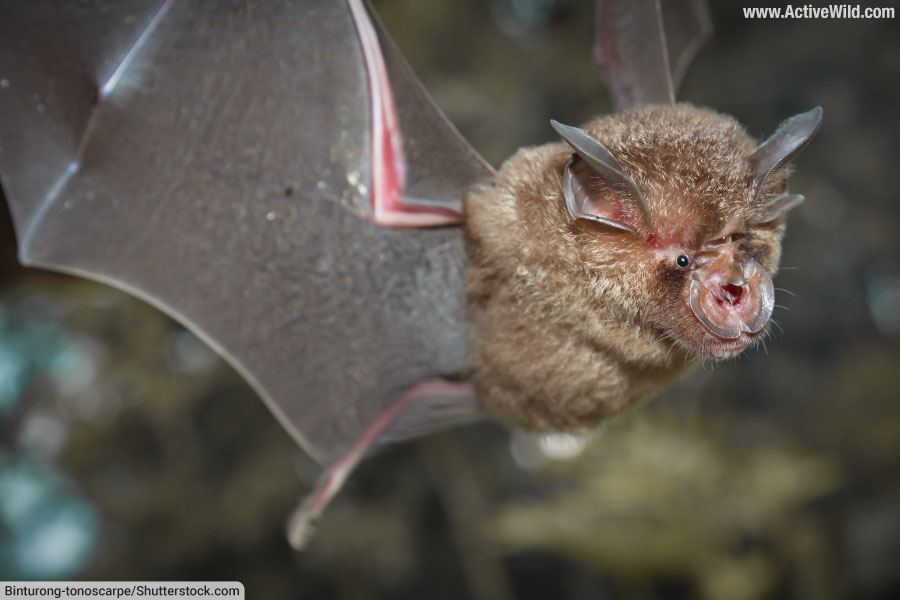
- Class of animal: Mammal
- Family: Rhinolophidae
- Conservation status: Various
Horseshoe bats are a diverse group of bats belonging to the family Rhinolophidae. They are characterized by their distinctive horseshoe-shaped noseleaf, which plays a crucial role in their echolocation abilities.
These bats emit high-frequency calls that bounce off objects, allowing them to navigate and locate prey in complete darkness.
Horseshoe bats are found across Asia, Africa, Europe, and parts of Oceania, inhabiting a variety of habitats, from caves to forests. They play a vital role in ecosystem health by controlling insect populations through their insectivorous diet, making them ecologically significant despite their relatively small size.
Discover More
Discover more about bats on this page: Bat Facts
Jackson’s Chameleon
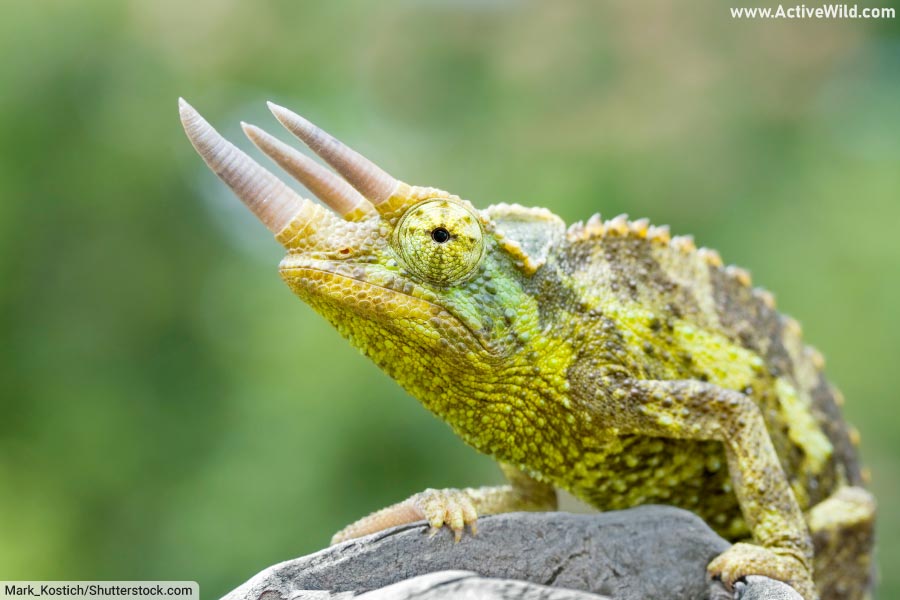
- Scientific name: Trioceros jacksonii
- Class of animal: Reptile
- Family: Chamaeleonidae
- Conservation status: Least Concern
Jackson’s Chameleon (Trioceros jacksonii) is a distinctive and small to medium-sized species of chameleon native to East Africa, particularly Kenya and Tanzania.
Renowned for its three horn-like projections on its head, with one on the snout and two above the eyes, this species is known for its remarkable color-changing abilities.
Typically arboreal (tree-dwelling) in nature, Jackson’s Chameleon inhabits a variety of forested and montane habitats. It’s also a popular choice in the pet trade due to its unique appearance.
Discover More
Discover different types of lizards on this page: Types of Lizards
You can find out more about reptiles on this page: Reptiles – The Ultimate Guide
Discover different types of reptiles on this page: Types of Reptiles
Kakapo
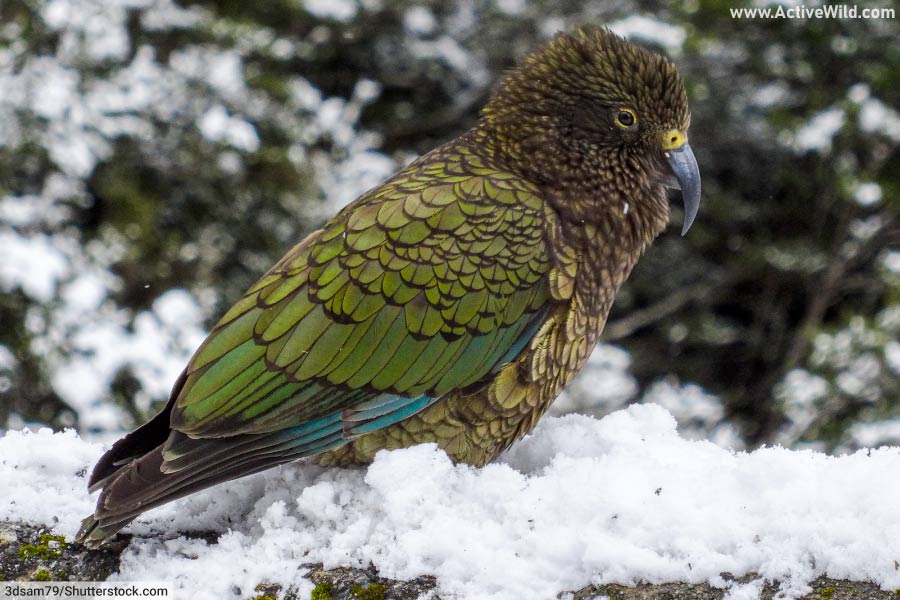
- Scientific name: Strigops habroptilus
- Class of animal: Bird
- Family: Strigopidae
- Conservation status: Critically Endangered
The kakapo is perhaps more “odd” than “ugly”. It is a large, flightless parrot that is found only in New Zealand. Although heavier than all other parrots (the species can reach weights of up to 4 kg), its wings are small, and used mainly for balance.
The kakapo is nocturnal, using its acute sense of smell to help it find food. Although its eyesight isn’t thought to be particularly sharp, it is able to see fairly well at dusk, unlike the virtually blind kiwi (another flightless, nocturnal bird of New Zealand).
The kakapo has a distinctive musky odor, which, unfortunately for this terrestrial bird, can reveal its location to predators.
This critically endangered bird breeds only once every two to five years, and only begins to breed at around five years of age.
Due to the introduction of predators such as cats and stoats to its native habitat, the slow-breeding kakapo’s population has decreased dramatically. Today, there are only around 116 adult kakapos left in the wild.
During the breeding season, male kakapos perform competitive displays known as leks, in which they attempt to impress females by making loud booming sounds. The deep boom of the male kakapo is one of the furthest-reaching songs of any bird.
With an average lifespan of around 60 years, the kakapo is one of the longest-lived of all birds. Individuals have reportedly reached 100 years of age.
Discover More
You can discover more amazing birds on this page: Amazing Birds List with Pictures & Facts
Naked Mole-Rat
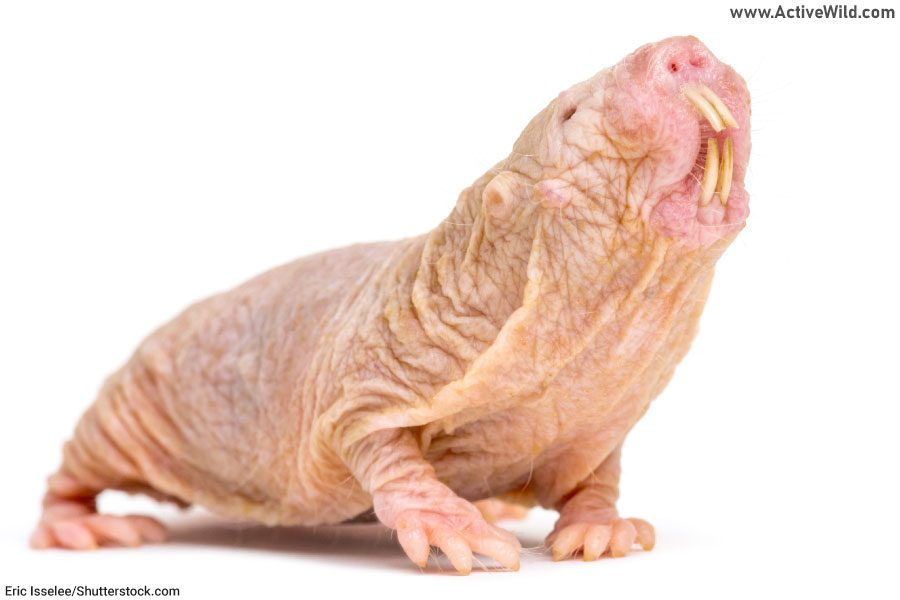
- Scientific name: Heterocephalus glaber
- Class of animal: Mammal
- Family: Heterocephalidae
- Conservation status: Least Concern
No list of ugly animals would be complete without the naked mole rat, an African rodent better known for its strange appearance than its remarkably complex social behavior.
The naked mole rat, as its name suggests, is largely hairless. It is also virtually cold-blooded – both adaptations for living underground. Another adaptation for burrowing is the species’ incisors – the long front teeth are used for digging.
This unusual mammal is found in the dry grasslands of East African countries such as Ethiopia, Kenya and Somalia. It inhabits complex tunnel networks that it excavates using its powerful teeth. A naked mole rat burrow can occupy over 100,000 square meters.
Unlike nearly all other mammals, the naked mole rat lives in colonies that are organized like those of social insects such as bees and ants – a system known as eusociality.
A single “queen” naked mole rat produces all of the colony’s young; only if she dies will another female begin to reproduce.
A naked mole rat colony usually contains around 80 individuals, although colonies of over 250 are known.
Discover More
You can find out more about rodents on this page: Rodents: The Ultimate Guide
You can see more African animals on this page: African Animals
North American Porcupine
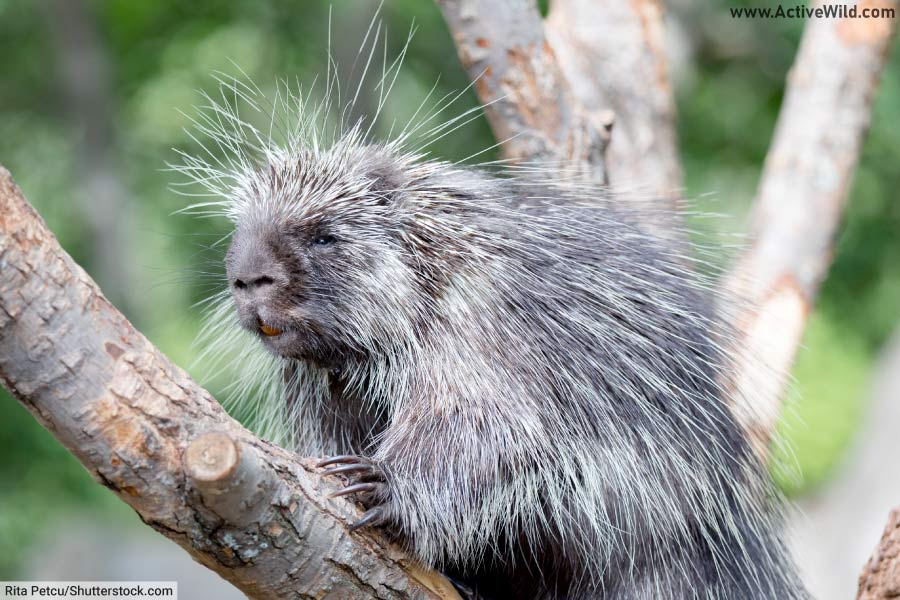
- Scientific name: Erethizon dorsatum
- Class of animal: Mammal
- Family: Erethizontidae
- Conservation status: Least Concern
Many rodents – for example, guinea pigs, chinchillas, and even the capybara – are regarded as being “cute and cuddly” animals. Not so much the North American porcupine, which, frankly, is neither.
The North American porcupine is the second-largest rodent found in North America (the largest is the North American beaver), and the seventh-largest of all living rodents.
This slow-moving mammal spends much of its life in trees, and is mainly active at night. Like all porcupines, the North American porcupine has a coat of sharp quills. The quills, which are actually modified hairs, are a defense against predators.
The North American porcupine belongs to the family Erethizontidae – a group of rodents known as the “New World Porcupines”. The New World porcupines are not closely related to the Old World porcupines of family Hystricidae – despite members of both groups being large, spined rodents.
Discover More
You can find out more about the North American Porcupine on this page: North American Porcupine Facts
You can find out more about rodents on this page: Rodents – The Ultimate Guide
Proboscis Monkey
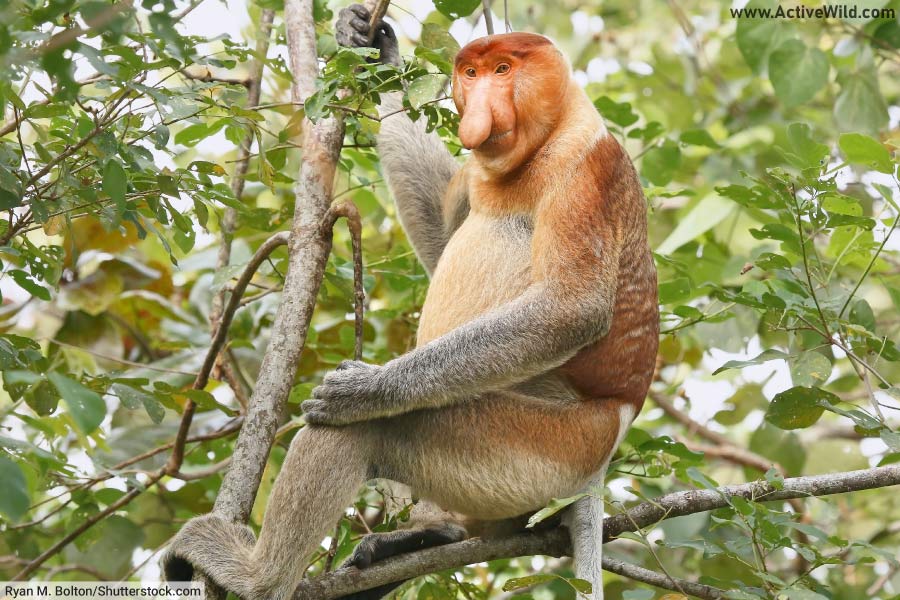
- Scientific name: Nasalis larvatus
- Class of animal: Mammal
- Family: Cercopithecidae
- Conservation status: Endangered
The proboscis monkey, due to its over-large nose, is one of the world’s best-known ugly animals.
This odd-looking primate is found only on the island of Borneo, and is one of Asia’s largest monkeys. It inhabits forests near rivers and mangrove forests (coastal forests that are waterlogged).
The proboscis monkey is strongly associated with water, and even has webbed toes for swimming – a skill that it uses to evade predators.
The long, fleshy nose of the male proboscis monkey serves to amplify its call, with females seemingly favoring males with louder calls. The female’s nose, while somewhat larger than that of other monkeys, does not reach anywhere near the size of the male’s.
Like many primates, the proboscis monkey is highly vocal. It will honk to warn the troop of predators, and shriek to express agitation or excitement.
Much of the proboscis monkey’s natural habitat has been destroyed by deforestation. With a decreasing population currently thought to contain fewer than 7,000 individuals, the proboscis monkey is an endangered species.
Discover More
You can find out more about the proboscis monkey on this page: Proboscis Monkey Facts
Discover more about monkeys on this page: Monkeys: The Ultimate Guide
Saiga Antelope
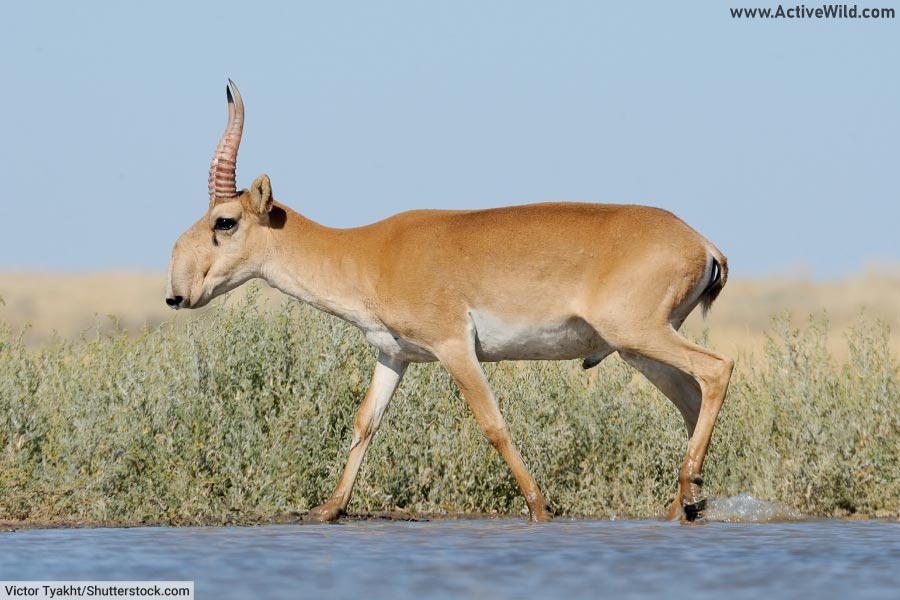
- Scientific name: Saiga tatarica
- Class of animal: Mammal
- Family: Bovidae
- Conservation status: Critically Endangered
The saiga antelope is an antelope found on steppes (dry grasslands) and deserts in Asia. The species is found in four countries: Kazakhstan, Mongolia, Russian Federation and Uzbekistan, but its dwindling population is fragmented into five separate populations.
The reason for the saiga’s inclusion in this list of ugly animals is its distinctive, downward-pointing nostrils. These are actually a useful adaptation for life in the dry grasslands, as they filter out dust, cool the antelope in the summer and warm the air the animal breathes in during the winter.
It may look odd to our eyes, but the saiga antelope’s unusual nose helps the animal to survive in the barren steppe habitat.
Once found in vast herds, the saiga was heavily hunted until around only one thousand individuals remained. Various political and economic changes in the region have prevented the species’ population recovering to its original size, and today the saiga antelope is critically endangered.
Discover More
You can see more Asian animals on this page: Asian Animals List with Pictures & Facts
Shoebill
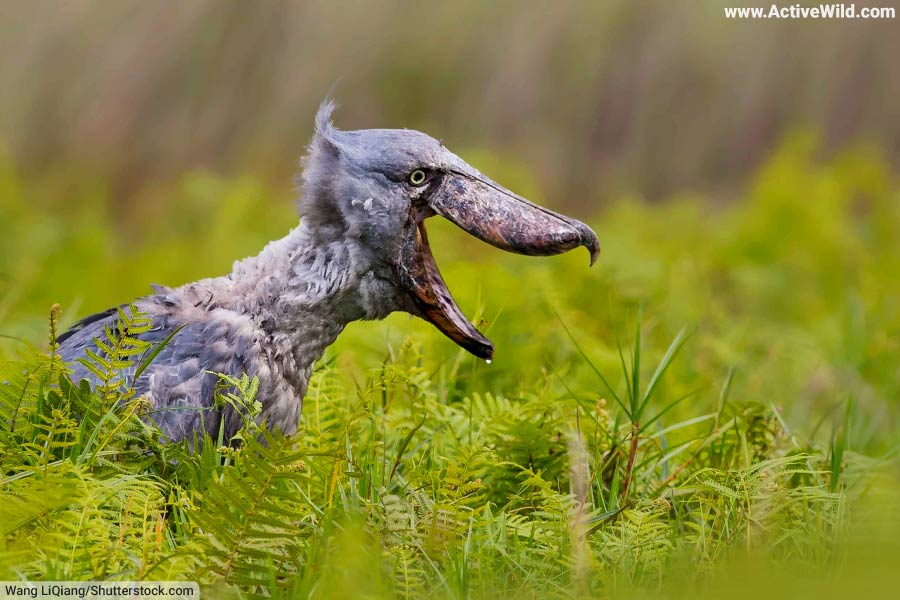
- Scientific name: Balaeniceps rex
- Class of animal: Bird
- Family: Balaenicipitidae
- Conservation status: Vulnerable
The Shoebill is a large and distinctive bird species native to the wetlands and swamps of tropical central tropical Africa.
Known for its imposing size, towering height, and massive shoe-shaped beak, this ugly bird is an apex predator in its habitat, preying on fish, amphibians, and even small mammals.
Shoebills have a prehistoric appearance, resembling creatures from a bygone era; they’re a good reminder that birds are descended from dinosaurs!
Discover More
You can find out more about birds on this page: Birds – The Ultimate Guide
Discover different types of birds on this page: Types of Birds
Southern Elephant Seal

- Scientific name: Mirounga leonina
- Class of animal: Mammal
- Family: Phocidae (earless seals or true seals)
- Conservation status: Least Concern
The southern elephant seal is one of two species of elephant seal, the other being the slightly smaller (but just as ugly) northern elephant seal, Mirounga angustirostris.
The southern elephant seal is found in cold, Antarctic & Sub-Antarctic waters; its northern cousin is found in the Eastern Pacific, along the coastlines of Canada, USA and Mexico.
The southern elephant seal is the world’s largest pinniped (the group of animals that includes all seals and sea lions) and dwarfs even the walrus, another member of this group.
A male southern elephant seal can reach up to 4 metric tons (4.41 short tons) in weight, and up to 6m / 20 ft. in length.
The female typically weighs 3 to 4 times less than the male – an example of extreme sexual dimorphism. (Sexual dimorphism is a difference in the appearance of males and females of the same species).
The elephant seals are named for the long, fleshy noses of the males (which resemble the trunks of elephants). The nose begins to grow when the seal reaches sexual maturity, and is used to produce the extremely loud roars that form part of the species’ dominance display.
Discover More
You can find out more about the southern elephant seal on this page: Southern Elephant Seal Facts
You can see more Antarctic animals on this page: Antarctic Animals List with Pictures and Facts
Discover more Antarctic seals on this page: Antarctic Seals
Thorny Devil
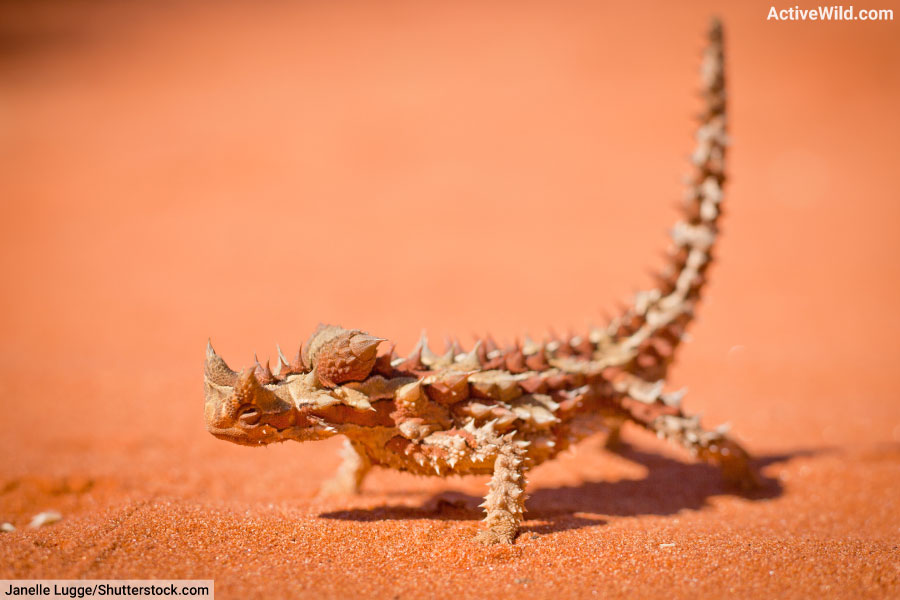
- Scientific name: Moloch horridus
- Class of animal: Reptile
- Family: Agamidae
- Conservation status: Least Concern
The Thorny Devil is a small lizard species native to the arid regions of Australia. Its most distinctive feature is its spiky, thorn-covered body, which acts as both camouflage and a deterrent against predators.
Despite its intimidating appearance, the Thorny Devil primarily feeds on ants, using its specialized tongue to collect them. These lizards have a unique water conservation mechanism, channeling moisture from their skin to their mouths via capillary action.
It may be an ugly animal, but the thorny devil is a testament to nature’s ingenuity in adapting to harsh desert environments.
Discover More
Discover different types of lizards on this page: Types of Lizards
You can see more Australian animals on this page: Australian Animals
Ugly Animals Book
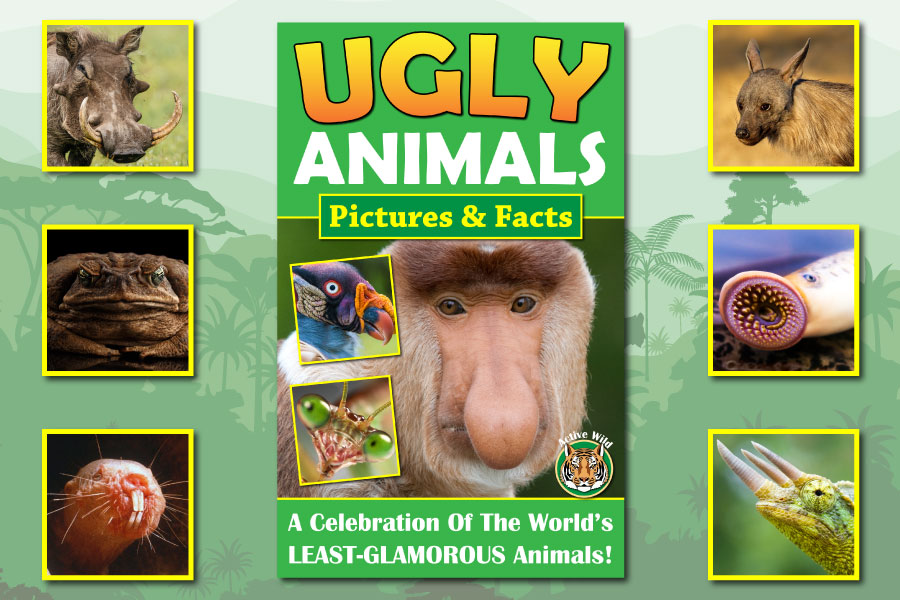
Check out our new book: Ugly Animals Pictures and Facts! View at Amazon.
Conclusion
The animals on this list may not be conventionally beautiful, but they are no less fascinating than other, “better-looking” species. In fact, the “ugly” characteristics of many of these animals have evolved to give them certain advantages, often allowing them to survive in habitats inaccessible to other species!
The world’s ugliest animals even have their own conservation group: the Ugly Animal Preservation Society!
Discover More About The Animal Kingdom With Active Wild
Animals: The Ultimate Guide To The Animal Kingdom
A to Z Animals List with Pictures & Facts
Rainforest Animals List with Pictures And Facts

